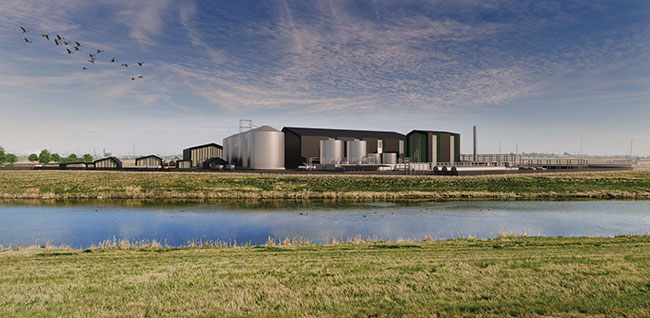
Fields of energy: Calgary project to turn low-grade wheat into ethanol and RNG
May 22, 2023
By
Maria Church
The Future Energy Park in Calgary – a flagship project from Alberta’s Green Impact Partners – plans to marry mission with money to create North America’s largest carbon-negative RNG and ethanol project.
 Future Energy Park’s facility in Southeast Calgary will turn non-food-grade wheat into fuels and cattle feed while sequestering carbon in a one-stop energy site. Photo rendering courtesy Green Impact Partners.
Future Energy Park’s facility in Southeast Calgary will turn non-food-grade wheat into fuels and cattle feed while sequestering carbon in a one-stop energy site. Photo rendering courtesy Green Impact Partners. Green Impact Partners (GIP) has a plan to marry mission with money, aligning sustainability and emission-reduction goals with business operations.
CEO Jesse Douglas says the company is focused on doing the right thing first from an environmental and social perspective, then making it profitable.
“Our whole focus is: Are we doing as much as we can with the project that’s there, irrespective of how it performs financially? Then we say, ‘Now what can we do to make it financially viable to be good stewards of capital, as well,’” Douglas explains.
The Alberta-based developer is advancing the Future Energy Park in Calgary – a flagship project that will create North America’s largest carbon-negative renewable natural gas (RNG) and ethanol facility.
The facility in Southeast Calgary will turn non-food-grade wheat into fuels and cattle feed while sequestering carbon in a one-stop energy site, complete with ethanol plant, anaerobic digesters, RNG facility, co-generation plant, water treatment plant, and carbon dioxide capture facility.
Future Energy Park is specifically designed to be waste-free, meaning all primary products and most by-products have an end use to utilize 100 per cent of the biomass going into its gates. As Douglas will tell you, at times that mission meant sacrificing easy profit streams, but they’re proving that doing “the right thing” can make financial sense, too.
Company origins
GIP as a company is only a few years old, but Douglas – based in Edmonton – has been an entrepreneur in the energy, construction and cleantech space for more than 20 years.
“We started in early 2000s making investments into technology that would green-up oil and gas,” he says. “We invested in a lot of science experiments and we more stumbled onto renewable natural gas and its impact.”
Their goal of having of immediate environmental impact pushed them down the road of biofuels with carbon capture and storage (CCS). “Right now, biofuels are the only carbon-neutral or carbon-negative renewable fuel available,” Douglas says. Wind and solar, by comparison, have an initial carbon footprint from construction or continued impact from arable land use that cannot, currently, be recovered.
After many years of a “head start,” tweaking technology and working with farmers to firm up feedstock supply, GIP incorporated in May 2021 and the team hit the ground running with plans for the Future Energy Park in Calgary.
Since 2021, the company has also announced majority ownership stakes in on-farm manure-based RNG projects in Iowa and Colorado, and another dozen of their projects in Canada and the U.S. are nearing ground-breaking milestones. With a total staff of more than 100, the company generates over $200 million in annual revenue.
In February, the company welcomed London, UK-based Amber Infrastructure as a 50-per cent project-level equity owner in Future Energy Park, Iowa RNG and GreenGas Colorado, which will inject $545 million into the projects.
Feedstock to fuel
A short growing season and unpredictable weather on the prairies results in up to 13 per cent of wheat crops downgrading to non-edible residue each season. Future Energy Park is designed as a one-stop shop to convert all of that non-food-grade wheat biomass into useable products.
“We don’t want to be taking food for fuel. We’re taking grade three wheat and there’s a substantial source of that in the prairies, even just within 500 kilometres of our site there’s enough to service it,” Douglas says.
Wheat entering the facility will first be utilized in the facility’s ethanol plant. The feedstock will be crushed, separated, fermented and distilled to create fuel pump-ready ethanol. The residuals from the ethanol production will then head to a tank farm for anaerobic digestion. Biogas is collected and piped into the RNG facility next door for upgrading to create pipeline-ready natural gas. Digestate from the tanks – a purely wheat-based product – will be dried and used as high-protein cattle feed.
The site includes a wastewater treatment plant to recycle water used during each process, and carbon dioxide created from the production of biofuels will be captured and compressed for sequestration.
Future Energy Park will be powered by a high-efficiency natural gas-fired cogeneration unit. Two gas turbines and two heat-recovery steam generators will produce power and steam for use throughout the facility.
GIP expects Future Energy Park to consume 900,000 tonnes a year of grade three wheat, producing approximately 3.5 million MMBtu per year of RNG and over 300 million litres of ethanol annually.
“We’re not using any new technology,” Douglas says. “We’re pushing ourselves to be more creative because we don’t want a waste source coming out of this. That’s consistent to what we do in all our projects.”
Mission focused
Future Energy Park is looking at breaking ground this summer.

Green Impact Partners CEO Jesse Douglas aims to prove that doing “the right thing” can make financial sense, too.
“We’re ready to start building and we’re excited,” Douglas says.
GIP is working with Alberta-based contractors for the design, engineering and construction, including PCL, Thermo Design Engineering, Propak Systems and EXP. Equipment contracts for the ethanol and RNG facilities and anaerobic digesters are mainly German manufacturers.
Once sold on the idea of the Future Energy Park, the City of Calgary was an encouraging partner, providing potential sites where they are hoping to grow their industrial zones, Douglas says. Calgary is also a good location from a values perspective as a place where the farming industry and energy industry co-exist.
Building on their momentum, GIP is looking at other potential sites across Canada to construct similar wheat-to-energy sites. The prairies alone could sustain three.
“We think it’s an important show of how you can take the farming industry and marry it with the energy industry, and do renewables that are synergistic with both,” Douglas says. “We’re not competitive with any of them, and we’re helping them to decarbonize their existing footprint.”
Domestic future for biofuels
When it comes to the growth of biofuels in Canada, Douglas says our domestic policy pales in comparison to the U.S. The clean fuels industry is hyper aware of the advantages the Inflation Reduction Act (IRA) has given to U.S. producers. The ripple effect is to make Canadian investment less cost competitive.
“The IRA is a very well-designed program that is going to advance the U.S. beyond the rest of the world,” Douglas says. “The U.S. has put the world on notice that they want renewables and biofuels pieces to go there.”
Here in Canada, Douglas says he hasn’t seen indication yet the federal government plans to be competitive with the U.S. program.
“They are still primarily focused on electrification and wind and solar,” he says. “I think those are needed parts of our grid, but I don’t think they’re the ultimate solution. I think the belief that we can get off fossil fuels is preventing investment into synergistic technologies and better uses of fossil fuels.”
While market forces would drive most biofuels producers to U.S. customers, GIP plans to keep the majority of its biofuels in Canada.
“We’re focused on doing the right thing, but also challenging what the right thing is,” Douglas says. “Just because it’s renewable, doesn’t mean it’s the right thing to do. There are projects for us, using the same technology as Future Energy Park, where we can’t make them make ‘impactful’ sense. Sometimes they make a lot of money, but we can’t get them to what we would call, doing the right thing.”
“And I think what we’re proving is that we can do the right thing and also be profitable,” he says. •
This article is part of Biofuels Week 2023. To read more articles on biofuels, click here.
Print this page